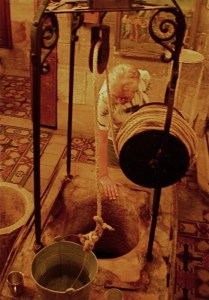Next we travel into the West Bank. This territory was supposed to be part of the Palestinian state, but it was captured by Jordan in the 1948 war and then by Israel in the 1967 war. Under the 1993 Oslo accords, the territory was divided into three areas A, B, and C with varying levels of autonomy with Israel in full control of Area C which is about 60% of the West Bank.
 |
| Church of the Ten Lepers |
“While Jesus was on the way to Jerusalem, He was passing between Samaria and Galilee. As He entered a village, He was met by ten lepers who stood at a distance; and they raised their voices and called out, “Jesus, Master, have mercy on us!” When He saw them, He said to them, “Go and show yourselves to the priests.” And as they went, they were healed and made clean. One of them, when he saw that he was healed, turned back, glorifying and praising and honoring God with a loud voice; and he lay face downward at Jesus’ feet, thanking Him. He was a Samaritan. Then Jesus asked, “Were not ten cleansed? Where are the other nine? Was there no one found to return and to give thanks and praise to God, except this foreigner” Jesus said to him, “Get up and go. Your faith has restored you to health.”
 |
| Ruins of St. John the Baptist Cathedral |
We visit the Palestinian town of Sebastia where Salome danced for Herod Antipas and he promised her anything that she wanted. She asked for the head of John the Baptist on a silver platter. John was captured and beheaded. It's said that his body was buried here in Sebastian, but even in death John did not rest because during an anti-Christian period his grave was desecrated and his body burnt with only a few bones saved by monks. The Crusaders build a cathedral, the largest in the area after the Church of the Holy Sepulchere, but after the Muslim conquest of 1187, it was turned into a mosque honoring Yahya, the Muslim name for John the Baptist.
Pilgrims still visit the tomb associated with John the Baptist and other prophets. Under a small domed building in the cathedral ruins, a narrow flight of 21 steps leads down to a tomb chamber with six burial niches set in the wall. Tradition places John the Baptist’s relics in the lower row, between those of Elisha and Obadiah.
 |
| Colonaded Street |
Sebastia was named by Herod to honor Augustus Caesar. It means The Greek "sebastos" means venerable which translates into the Latin , "augustus" In the extensive archaeological park at the top of the hill are remnants of Ahab’s palace, identified by the discovery of carved ivory that was mentioned in the Bible. Also to be seen are the stone steps leading to Herod the Great’s temple of Augustus, an 800-metre colonnaded street, a Roman theatre and forum, and a city gate flanked by two watchtowers. These are the remnants of six successive groups that lived here.
 |
| Roman theatre |
 |
| Stone Steps of Herod the Great |
 |
| Church of St. Photina |
We visit Jacob's well, which some say is one of the most authentic sites the Holy Land since this well is mentioned in Jewish, Christian and Muslim traditions and has been around for more than 2000 years. The deep well was in a good spot at the entrance between the two mountains. It was at this spot that Jesus met the Samaritan woman and promised her living water.
 |
| Jacob's Well |
Access to Jacob's well is through the Orthodox church of St. Photina (Svetlana in Russian) which is the traditional name given to the Samaritan woman. Photina was a martyr who was thrown down a well in Rome by good ole Emperor Nero. The church is a modern one built in 2007 modeled after a crusader era church. Like some of the other sites we've seen, the first church dates from around 380.
This area is the site of tension over the years. First it was between Samaritans and Jews. Samaritans have their roots in Judaism but only believe in the first five books of the Bible, the Torah. There are very few Samaritans left, but there was conflict here during the Second Intifada, however, the area is growing as a commercial center and in tourism.
We end our day in Jerusalem which will be our home for the next five nights. I feel like we should be bringing palm.



To my scant knowledge the wells were gathering spots for socialization. I believe the well possibly Father Jacobo. Well is where Father Jacob met and married Rachael and Leah. He loved Rachael but she died. according to Jewish text. So he married Leah. They conceived 12 sons.
ReplyDelete. These sons grew up and this is the origin of the 12 tribes of Israel. 10 of the 12 tribes disappeared. No explanation till this day as to what happened.
Father Abraham and Sara, Father.
Issac and Rivka. Father Jacob and and Leah. They are all buried in the cave of ? I always wanted to visit the cave. Perhaps one day. Rachael who died prematurely is not buried in the cave. She was buried by her beloved husband on a famous path I think outside of Israel. They say that Mother Rachael cries for her people. Her burial place is famous and is visited by many people every day of the year. People go to her burial site for blessings and to pray for their needs. They say everyone cries at her burial site. Lately it is best to go with other people. The site has caused a lot of commotion. But it sounds interesting